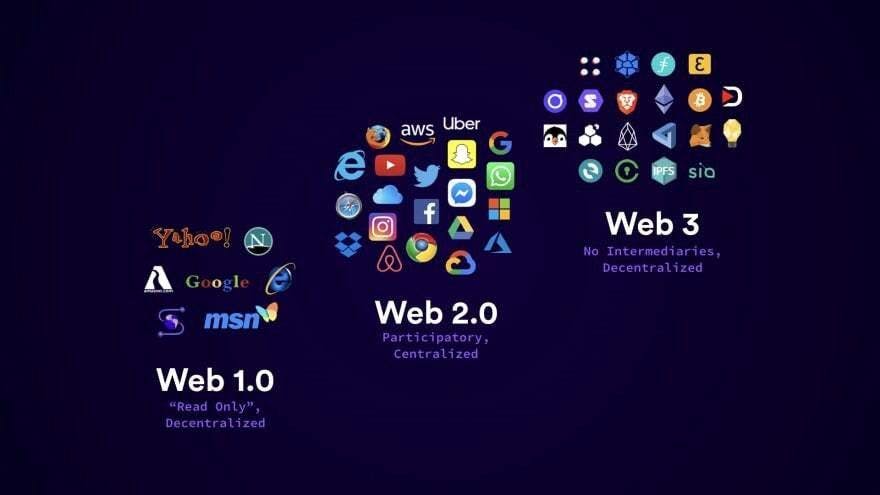Introduction: What is Web3.0?
Web3.0 is the next generation of the internet. It is an internet that is decentralized and democratized, with a focus on privacy, security, and user-centricity. The structure of the internet has gone through many iterations, most recently, with the arrival of Web 2.0, we saw personalization and social media apps being introduced to make the web a better place for users.
The next iteration Web 3.0—is not so much about a new type of site or app as it is about a new way for people to use the sites and apps that already exist. The idea of Web 3.0 is based on trust, control, and privacy—these are things that are important to users who want to participate in a decentralized world by using tools like social media platforms and virtual reality headsets.
One big contrast between Web 2.0 and Web 3.0 is a lack of centralized control. Here is a delightful little illustration of how the web has evolved since the 1990s:
-
Web 1.0 - 1990s, things like email and search engines were in their infancy and there was no real concept of 'the internet'.
-
Web 2.0 - 2000-present, personalization and social media apps were introduced to make the web a better place for users.
-
The next iteration—Web 3.0—is not so much about a new type of site or app as it is about a new way for people to use the sites and apps that already exist.
Web3.0 has been called “the new Web” or “the decentralized web” because it has evolved from the current web (or Web2.0) which is centralized and controlled by corporations like Facebook, Google, Amazon, etc.
What is the Difference Between Web3.0, Web2.0, and Web1.0?
-
Web3.0 is the next evolution of the Internet that is set to change the way we live and interact with one another. The World Wide Web of today is a web of documents, where each document lives in isolation on a server somewhere on the Internet. Web2.0 is characterized by social networks, wikis, and collaborative content creation. The first generation of the web was a web of documents, but Web1.0 was about connecting people.
-
Web3.0 will be about connecting people and data to power new applications and opportunities for everyone on earth- from governments to NGOs to multinational corporations to startups
Web2 - The Present of the Internet
-
The web is a place of constant change, and the internet is no exception. The web has gone through three major revolutions in its lifetime, each with a different impact on the internet.
-
Web 1.0 took place in the early 1990s and was characterized by static HTML pages that were difficult to update and did not allow for interactivity. Web 2.0 revolutionized the internet by using dynamic pages that could be updated quickly, allowed for interactivity, and had social media integration. Web 3.0 is what we are currently seeing today with the increased use of artificial intelligence in our daily lives.
Web1 - The Past of the Internet
-
The internet is a vast place with millions of pages and content. It is hard to keep track of everything that is happening on the web, but there are some websites that try to do just that. One of these websites is called Web1, which was created by a group of MIT students in 1995. The website was designed as a way for users to explore the history of what has happened on the internet so far.
-
Web1 started out as an online scrapbook for people's old websites, but it has evolved into an interactive timeline with many different features like maps and search bars. This website has been around for over 20 years and it still continues to grow as more websites are added each day.
Web3 - The Future of the Internet
-
The internet of today is a centralized system that is dominated by a few key players. Web3 will change this by creating a decentralized network that will be more secure, more private, and more equitable.
-
Web3 is the future of the internet, and it will change everything. It’s not just about decentralizing the web – it’s about decentralizing everything. Web3 means being able to access information without going through an intermediary, like an ISP or Google, or Facebook. It means being able to interact with one another without having to go through a central authority. It means all of us being able to own our data, instead of handing over all of our data to big companies like Facebook and Google in exchange for “free” services. And it means building systems that
What are the Benefits of Web3.0?
Web 3.0 is the next generation of the World Wide Web, which will be a decentralized web where users are in control. It will be an internet that is not owned by any company or individual, but instead by the people, for the people.
The main benefits of Web3.0 are:
- Freedom from censorship
- Freedom from centralized control
- Freedom from data ownership and privacy
Conclusion: Why You Should Care About Web3.0
-
We are at the beginning of a new era of web development. Web3.0 is a new paradigm in the way we think about the internet. It has been called the “Programmable Web”, “Web of Apps”, “Web of Things” and many more names.
-
The web is not just a place for people to read content anymore; it is also about data-driven interactions and transactions between people and objects in our lives.


